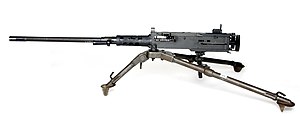The M2 machine gun or Browning .50 caliber machine gun (informally, "Ma Deuce"[14][15]) is a heavy machine gun that was designed near the end of World War I by John Browning. While similar to Browning's M1919 Browning machine gun, which was chambered for the .30-06 cartridge, the M2 uses Browning's larger and more powerful .50 BMG (12.7 mm) cartridge. The design has had many designations; the official U.S. military designation for the infantry type is Browning Machine Gun, Cal. .50, M2, HB, Flexible. It has been used against infantry, light armored vehicles, watercraft, light fortifications, and low-flying aircraft.
The gun has been used extensively as a vehicle weapon and for aircraft armament by the United States since the 1930s. It was heavily used during World War II, the Korean War, the Vietnam War, the Falklands War, the Soviet–Afghan War, the Gulf War, the Iraq War, and the War in Afghanistan. It is the primary heavy machine gun of NATO countries and has been used by many other countries as well. U.S. forces have used the M2 longer than any other firearm except the .45 ACP M1911 pistol, which was also designed by John Browning.
The M2HB (heavy barrel) is manufactured in the U.S. by General Dynamics,[16] Ohio Ordnance Works,[17] U.S. Ordnance,[18] and FN Herstal for sale to the U.S. government and other nations via Foreign Military Sales.
- ^ Yates, Lawrence A. (July 1988). Power Pack: U.S. Intervention in the Dominican Republic, 1965-1966 (PDF). Leavenworth Papers, Number 15. United States Army Command and General Staff College. p. 123.
- ^ "A Rwandan government soldier fires on June 12, 1994 to Rwandan".
- ^ FUNKER530 - Veteran Community & Combat Footage (21 June 2013). "50 Cal. Gunner Engages Taliban Positions During Ambush". YouTube. Archived from the original on 16 March 2017. Retrieved 4 June 2017.
{{cite web}}: CS1 maint: numeric names: authors list (link) - ^ "Iraqi Capture of Saqlawiyah Northwest of Fallujah From Da'esh". YouTube. Archived from the original on 2 June 2016. Retrieved 4 June 2017.
- ^ "Ukraine has received Browning .50 caliber heavy machine gun". Bulgarian Military. 22 March 2022. Retrieved 24 March 2022.
- ^ "Report: Profiling the Small Arms Industry". World Policy Institute. November 2000. Archived from the original on 11 October 2017. Retrieved 15 July 2010.
- ^ "FM 23-65 Browning Machine Gun caliber.50 HB, M2 2002". 23 December 2002.
- ^ a b "FN M2HB-QCB". FN Herstal. Archived from the original on 25 December 2014. Retrieved 25 December 2014.
- ^ Dunlap 1948, pp. 310–311.
- ^ Chinn 1951, III pp. 315, 323–334. In 1939, H. Arnold sought a cyclic rate greater that 1000 rounds/minute. The T25E3 gun was standardized as M3, and 2,400 had been made by September 1945. "The standardized basic machine gun fired at the rate of 1,200 rounds per minute."
- ^ "Army Ammunition Data Sheets for Small Caliber Ammunition" (PDF). Defense Technical Information Center. April 1994. p. 150. Archived from the original (PDF) on 2 December 2007. Retrieved 27 August 2010.
- ^ "FM 23-65 Browning Machine Gun caliber.50 HB, M2 2002". 23 December 2002.
- ^ https://www.usord.com/content/docs/manuals/usord_m2hb_op-manual.pdf [bare URL PDF]
- ^ "24th MEU ACE 'lock and load' Ma Deuce: photo essay". 24th Marine Expeditionary Unit. Retrieved 31 May 2022.
- ^ Rottman, Gordon (2008). The US Army in the Vietnam War 1965–73. Reading, UK: Osprey Publishing. p. 56. ISBN 978-1-84603-239-4.
- ^ "Contracts for Friday, September 3, 2010". Defense.gov. Archived from the original on 29 May 2011. Retrieved 19 September 2011.
- ^ ".50 M2HB QCB (M2A1)". Ohio Ordnance Military. 28 October 2016. Retrieved 24 August 2020.
- ^ "Contracts for Wednesday, July 15, 2009". Defense.gov. Archived from the original on 29 May 2011. Retrieved 19 September 2011.
